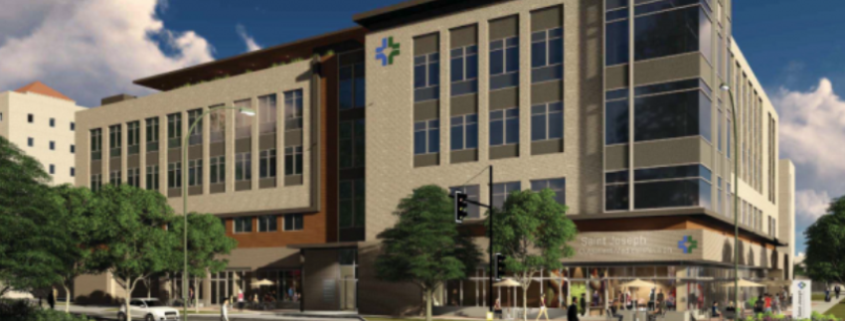Medical Concierges, Telehealth, Experience Define Healthcare Real Estate’s Brand-New World
Around the country, the ways consumers choose to access healthcare is undergoing a seismic shift. And those changes are affecting the locations health providers choose, the space they need and the ways they want to build it.
Patients across all demographics are leaning toward easily accessible, convenient healthcare systems and starting to warm to things like telehealth and digital offerings. Meanwhile, advances in technology are happening at a rapid clip, changing the way healthcare providers now practice medicine and casting uncertainty on how it will be done in the future.
“We really don’t know what these buildings are going to be and look like 10 years from now,” Gilbane Building Co. Vice President Peter Mulcahey said at Bisnow’s National Healthcare East event Wednesday.
“I think, if we all sat here 10 years ago and said, ‘Most of the medicine we want to deliver is through iPad interface and we only want to do critical services within four walls’ …. the reality hadn’t quite set in, otherwise we would have been prepared for where we are right now.”
Medical facility designers could be forgiven for their lack of foresight: The iPad was only announced eight years ago, and back then there were broad questions about whether Steve Jobs’ latest invention had any practical use at all.
As healthcare delivery evolves and more outpatient facilities are developed, Mulcahey said, there needs to be a focus on making sure structures are built to allow for flexibility down the road.
That may mean including more square footage in new or redesigned buildings, he said, to make way for repurposing as needed.
Others said changes to the way hospital services are provided are looming. Just as retail has morphed from physical stores to online, developments in technology will increasingly take healthcare into people’s homes.
“For those whose livelihoods depend on bricks-and-mortar of hospitals, sorry to disappoint you, but the hospital room of the future is likely to be the bedrooms of people across the country,” Partners Continuing Care and Spaulding Rehabilitation Network President David Storto said. “Imagine, for those of you who remember, [1970s TV doctor] Marcus Welby with all the technology that is available today.”
Panelists said treating patients remotely is fast becoming a key element to healthcare. Children’s National Health System in D.C. has been working in telemedicine for two decades, for example, and New York-Presbyterian is one of the largest telehealth providers in the country, according to Chief Strategy Officer Emme Deland.
Still, Deland said, even though telehealth is crucial to supporting patients, the healthcare industry needs to start preparing inpatient facilities for the aging population.
“We’ve done an analysis of what is going to happen over the next 10 years,” Deland told the audience. “If you take into consideration the technology and the population … We will see a slight decrease in the number of discharges, but we will see an increase in the number of patient days because people will be sicker and hospitalized. So we do need to have our inpatient facility [and] we do need to figure out our additional intensive care space.”
These changes are all playing out in healthcare providers’ search for locations, and the type of space they choose.
“You are seeing [a] greater number of practitioners in one space, more one-stop shops, so providing many services under one roof,” said broker Paul Wexler, the head of the Wexler Healthcare Properties Team at Corcoran, who added easy-to-access locations are in high demand.
He and his team recently arranged for a 17K SF outpatient center to go into a former movie theater at 1210 Second Ave. and for a 5K SF obstetrician and gynecologist clinic at 260 East 62nd St., he said.
“As much as retailers are trying to create that experience … healthcare providers are recognizing the same need to create the same experience,” he said. “Everything from the fast and efficient way they move people through the office to the overall experience of checking in and out.”
Mount Sinai Health Real Estate Division Vice President Tom Ahn agreed that type of one-stop shopping option — where you can see a primary care doctor, have blood drawn and get an MRI done in one place — is a major part of his hospital’s expansion.
Earlier this year, Mount Sinai announced a plan to build an 18K SF health center at 55 Hudson Yards, which will serve the companies with offices at the megaproject and the residents who live in the high-end condominiums and rentals there. Ahn said that location will be unique in that it will be a “concierge” health service, which is a path many providers are now taking.
Ultimately, he said, it is about standing out to patients and consumers.
“If we are not convenient and in a good location, providing all those services, we aren’t going to be competitive,” he said. “So that’s an important piece of our strategy, and that’s an important part of a lot of institutions’ strategy right now.”
While carving out that strategy, both in terms of location and service, in the shifting healthcare environment is imperative, panelists said patients will still seek out doctors and practitioners they feel they can trust.
“So [healthcare] is going to be less physical and more digital … A 25-year-old should be using 90% of his healthcare digitally… [for a] 45-year-old that will change, a 65-year-old will use 50% digital,” CityMD CEO Dr. Richard Park said. “AI, technology, that’s all important and needed. But humanity — that is the missing piece of healthcare.”
Source: Bisnow




